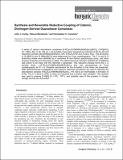Synthesis and Reversible Reductive Coupling of Cationic, Dinitrogen-Derived Diazoalkane Complexes
Author(s)
Curley, John J.; Murahashi, Tetsuro; Cummins, Christopher C.
DownloadDiazoalkanes Manuscript.pdf (1.997Mb)
PUBLISHER_POLICY
Publisher Policy
Article is made available in accordance with the publisher's policy and may be subject to US copyright law. Please refer to the publisher's site for terms of use.
Terms of use
Metadata
Show full item recordAbstract
A series of cationic diazoalkane complexes [4-RC6H4C(H)NNMo(N[t-Bu]Ar)3][AlCl4] 4-RC subscript 6 H subscript 4 C(H)NNMo(N[t-Bu]Ar) subscript 3] [AlCl subscript 4]], [1-R][AlCl4] (R = NMe2, Me, H, Br, CN; Ar = 3,5-C6H3Me2) [[1-R][AlCl subscript 4] (R = NMe subscript 2, Me, H, Br, CN; Ar = 3,5-C subscript 6 H subscript 3 Me subscript 2)] has been prepared by treatment of the N2-derived [N subscript 2 derived] diazenido complex Me3SiNNMo(N[t-Bu]Ar)3 [Me subscript 3 SiNNMo(N[t-Bu]Ar) subscript 3] with 4-RC6H4CHO [4-RC subscript 6 H subscript 4 CHO] and 2 equiv of AlCl3 [AlCl subscript 3]. The structures of [1-H][AlCl4] [AlCl subscript 4] and [1-NMe2][AlCl4] [[1-NMe subscript 2][AlCl subscript 4]were determined by X-ray crystallography. The C−N and N−N stretching modes were identified by a combined IR and Raman spectroscopy study, and other physical properties are discussed in detail. The electrochemical reduction potential for [1-R][AlCl4] [AlCl subscript 4] was shown to be linear with the Hammett σ [delta] parameter. This reduction process forms the C−C bonded dimer, [μ-(4-RC6H4C(H)NN)2[Mo(N[t-Bu]Ar)3]2 [μ [mu]-(4-RC subscript 6 H subscript 4 C(H)NN) subscript 2 [Mo(N[t-Bu]Ar) subscript 3] subscript 2], that was characterized by X-ray crystallography for R = H. Possible mechanisms for the formation of this dimer are presented. Both electrochemical investigations and quantum chemical calculations are used to describe the odd-electron complex 4-RC6H4C(H)NNMo(N[t-Bu]Ar)3 [4-RC subscript 6 H subscript 4 C(H)NNMo(N[t-Bu]Ar) subscript 3], 1-R, that is an intermediate in the formation of [1-R]2 [[1-R] subscript 2]. The C−C bond in [1-R]2 [[1-R] subscript 2] is redox-noninnocent and is broken upon oxidation. This reaction was used to prepare [1-H][A] (A = PF6−, OTf−) [(A = PF subscript 6-,OTf-)], and possible uses of this property in charge-storage devices are discussed.
Date issued
2009-06Department
Massachusetts Institute of Technology. Department of ChemistryJournal
Inorganic Chemistry
Publisher
American Chemical Society
Citation
Curley, John J., Tetsuro Murahashi, and Christopher C. Cummins. “Synthesis and Reversible Reductive Coupling of Cationic, Dinitrogen-Derived Diazoalkane Complexes.” Inorganic Chemistry 48.15 (2009) : 7181-7193. Copyright © 2009 American Chemical Society
Version: Author's final manuscript
ISSN
0020-1669